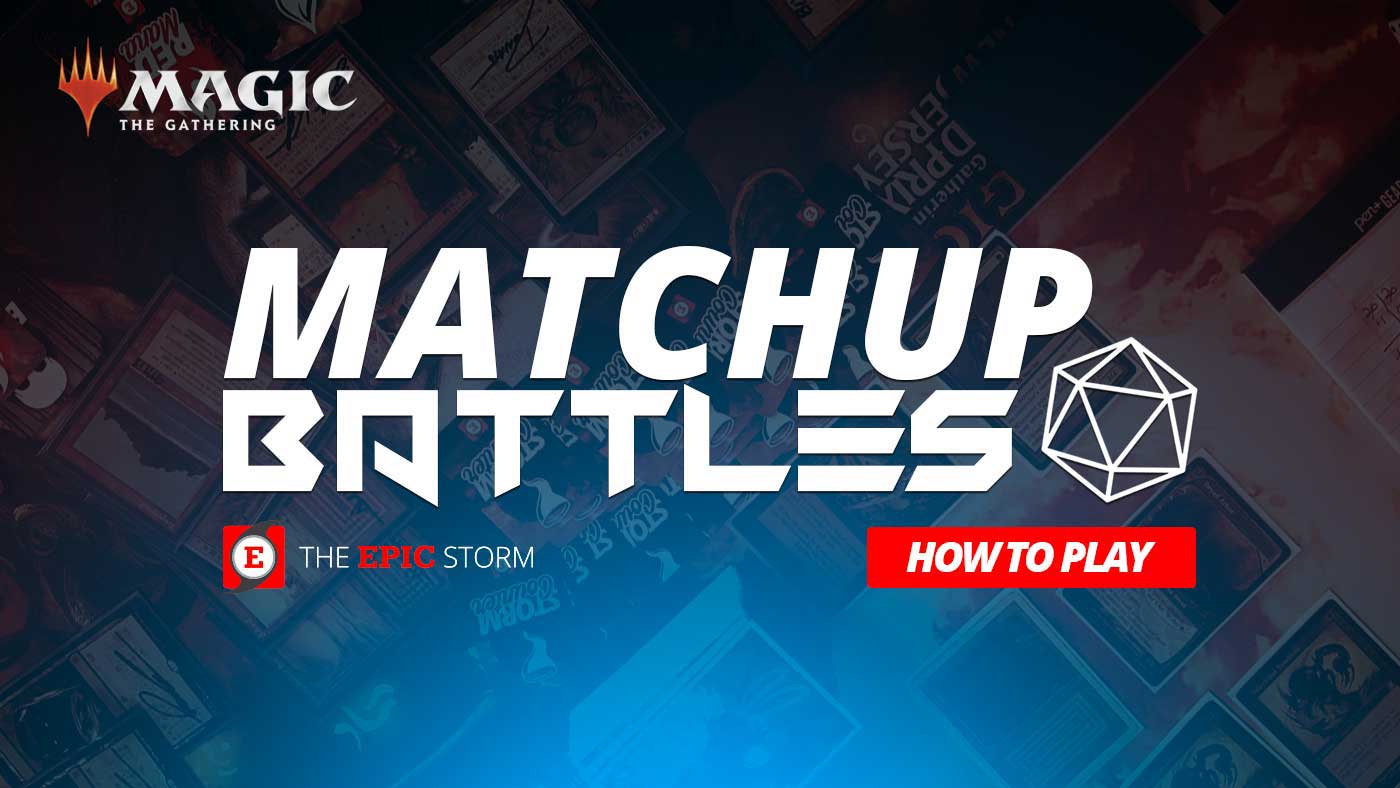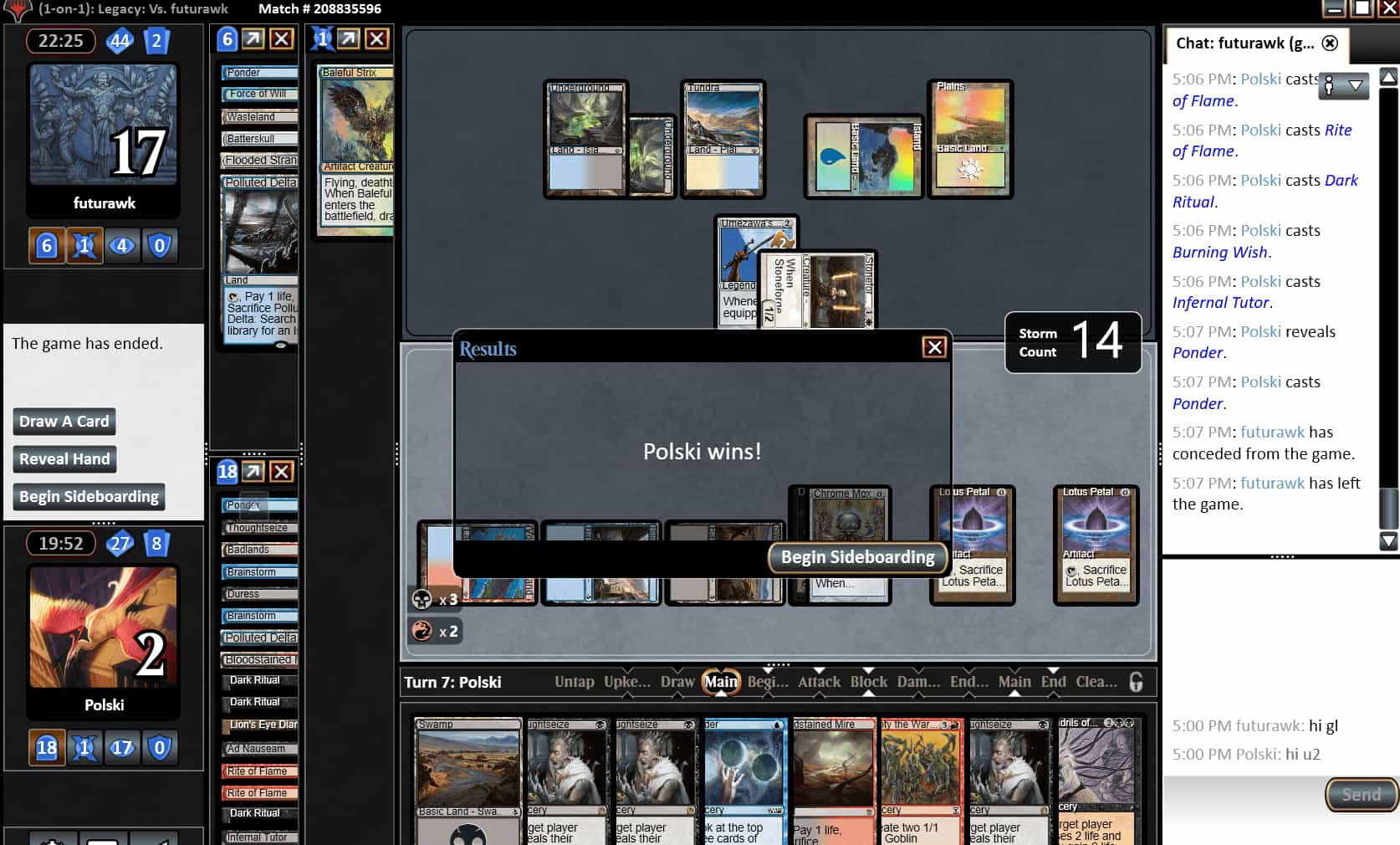Esper Stoneblade and other Stoneblade variations have been around for a long time ever since the printing of
Stoneforge Mystic and
Jace, the Mind Sculptor. It has gone through waves of success from being one of the best decks, down to pretty bad, and then back up to good again. Because of the recent bannings over the past year or two, especially
Deathrite Shaman, there is more of a reason to play fairer UW Midrange decks, and Stoneblade has filled that role. Esper Stoneblade is a midrange deck that tries to abuse
Stoneforge Mystic and some of the most powerful equipment printed, like
Batterskull and
Umezawa's Jitte. It tries to disrupt the opponent using counterspells in combination with discard spells. Because they are a blue-based deck they can often shift their role from being aggressive or midrange, to being pure control with cards like
Jace, the Mind Sculptor. Stoneblade is an archetype with many flavors ranging on the aggro-control spectrum, with cards like
Delver of Secrets to be aggressive or
Jace, the Mind Sculptor for control. As of late, Esper Stoneblade has been the more commonly played deck online. For us storm players it is important for us to understand this matchup and what the opponents game plan is when facing us.
How does Esper Stoneblade matchup against TES?
Stoneforge Mystic, Umezawa's Jitte, Batterskull, Toxic Deluge - While typically these cards don't sound that great vs storm it does cut off one of our main avenues of winning, Empty the Warrens. Sometimes you can overrun them or put them to a low life total before an equipment comes down and it can be good enough, but often I try to avoid Empty the Warrens in this matchup because of this package being able to gain a bunch of life or kill off our tokens. You can use a discard spell post-Stoneforge Mystic to take the equipment, and then go for Empty the Warrens, but those types of games are rarer, so I don't rely on it. Stoneblade also tends to run at least one variant of a wrath effect whether it's Toxic Deluge or something else. This is another strike against goblins, so there is just too much risk.
Force of Will, Flusterstorm, Spell Pierce - Like all other blue decks, it comes with a suite of counterspells. Something we are all familiar with and will be the primary angle that we will have to beat as it is their main way of disrupting us. This is where having 8 discard spells really comes in handy.
Thoughtseize - One of the best ways to beat storm is to attack it from multiple different angles, and the black part of Esper Stoneblade helps accomplish that with discard spells. The combination of discard backed up with counterspells is a pretty good recipe for beating us. Discard is something we should all be used to playing against, and the same rules apply here. It's kind of hard to play around, but the best thing we can do is to make sure when casting our cantrips to hide our most important cards on top of our library until we need them. This is a matchup where I see most players be sloppy when doing this. Because discard spells aren't common out of base UW decks they don't think about it and a random Thoughtseize goes on the stack and they lose. Stay focused and remember this is an axis that they can play on.
Wasteland - Not all variants play Wasteland, but a lot of them play at least a couple. With the rise of the Marit Lage decks, people are playing a couple copies. This is a card we should at least keep in mind and try to play around when possible. Not all hands give us access to play around, but if possible then we should. Don't make your hand slower or awkward just to play around Marit Lage that you're not even sure they're playing, especially if they aren't a Delver of Secrets deck. If they are leaning on a more controlling build then the chances of them playing Wasteland are lower.
Ethersworn Canonist, Meddling Mage - In the sideboard Stoneblade can play a wide range of anti-storm permanents like Ethersworn Canonist or Meddling Mage. This becomes extremely difficult to beat because it's just one more angle that they can attack from, and makes us bring in sideboard cards that we don't really want against typical blue control decks. The combination of Wasteland, discard, counters, and permanents is four different angles of attack and makes coming up with a game plan preemptively incredibly difficult since each game can play out differently. It is up to us to make sure our combo and our reactive cards, like discard and abrupt decay, line up with the disruption that they draw. These permanent based hate cards force us to respect the board a little more than we would like, and thus we need to bring in Abrupt Decay.
Deck List
Ways to win this matchup



Killing Them and Our Game Plan
The key turns of the game are usually going to be turns 3-5. This is not a matchup where we are trying to be blitz fast, but rather formulate a game plan over the course of a couple turns to try to win through their numerous pieces of disruption. The first couple turns of the game will be both players playing land drops, casting cantrips, using discard spells, and just setting up to execute their plan. Usually, games involve trading resources back and forth with Wasteland, both players discard spells and counters. After a couple turns the dust settles and usually whoever has the better cards leftover wins. This is one of the reasons why we keep all the copies of Ponder in and aim for a higher threat density instead of leaving Rite of Flame in. We want cards that are either interactive, a threat card, or our best rituals. By turns 3-5 the game will have developed enough to get a good understanding of each players role and what they need to do to try to win. From our perspective, we should know their hand, know how many turns we have to win, and whether there's a permanent in play we have to deal with. Once we get that understanding we can then try to combo around what they have.
Even if we have a kill in hand on turns 1-2 I would only go for it if they are tapped out, you know their hand, or if you think your hand can't compete in a longer game. That can be hard to judge, but basically, there is no hard rule of "never go for it on turn 1", but just know there's risk to that. Evaluating when you can afford to wait to play around something vs just jamming and taking the odds they don't have a counter is something that takes some experience and practice.
Sideboarding
To start off with the easy part I like to cut the Empty the Warrens because of all the reasons I described above with all their answers to beat it. Then I bring in Tendrils of Agony to make sure I have at least one win condition in my deck in case of Surgical Extraction. Surgical Extraction isn't that great of a card against us, but just in case I don't want it to be good. The three copies of Xantid Swarm and two copies of Abrupt Decay are kind of obvious because the opponent is going to have many counters and a good chance of a couple permanent based hate cards. We don't want to be overloaded with this effect because they have a small number of permanent hate, and we don't want to be diluted. Bryant Cook has also been trying a different sideboarding strategy with cutting all of the copies of Rite of Flame instead of trimming Chrome Mox and Ponder. By keeping those cards in your deck you're keeping a high threat density while also trying to kill quickly before the opponent can set up with all their angles of disruption. Chrome Mox will also keep our Ad Nauseam better than Rite of Flame will.
(adsbygoogle = window.adsbygoogle || []).push({});
Game Play
Onto an example match!
I am a couple turns into the game and I've cast two discard spells, one eating a Force of Will and the other taking a Batterskull post-Stoneforge Mystic leaving him with two copies of Swords to Plowshares in his hand. He draws a Umezawa's Jitte on his past draw step and casts + equips it to attack me. I need to rip a business spell in the next couple draw steps. I take my draw step and it's a Brainstorm. Draw 3...Ad Nauseam!!
 It becomes pretty easy from here to just play a bunch of mana and Ad Nauseam with plenty of mana floating to win from there. The opponent has Swords to Plowshares in hand and a Umezawa's Jitte with counters on it to be able to gain life, so it's important to get more than 10 storm.
It becomes pretty easy from here to just play a bunch of mana and Ad Nauseam with plenty of mana floating to win from there. The opponent has Swords to Plowshares in hand and a Umezawa's Jitte with counters on it to be able to gain life, so it's important to get more than 10 storm.

 Up 1-0
Game 2 and I keep my 7, but my opponent mulligans to 6. He starts off the game, and we both lead with turn one cantrips. On his second turn, he slams Damping Sphere. Wow...wasn't expecting that one.
Up 1-0
Game 2 and I keep my 7, but my opponent mulligans to 6. He starts off the game, and we both lead with turn one cantrips. On his second turn, he slams Damping Sphere. Wow...wasn't expecting that one.
 From there it's pretty downhill as I don't find any of my two copies of Abrupt Decay and I die a few turns later.
1-1
I decide to trim a couple cantrips and one Chrome Mox to make room for Echoing Truth since the opponent clearly doesn't want to lose to storm and has permanent hate.
Game 3 I have the choice of leading turn 1 cantrip or a discard spell, and I opt for the cantrip thinking they can't play any hate on turn 1, and it gives me 1 more card to know about if I use my discard spell on the second turn. Unfortunately when I do that I let me opponent have the opportunity to counter my discard spell, and that's what they do.
From there it's pretty downhill as I don't find any of my two copies of Abrupt Decay and I die a few turns later.
1-1
I decide to trim a couple cantrips and one Chrome Mox to make room for Echoing Truth since the opponent clearly doesn't want to lose to storm and has permanent hate.
Game 3 I have the choice of leading turn 1 cantrip or a discard spell, and I opt for the cantrip thinking they can't play any hate on turn 1, and it gives me 1 more card to know about if I use my discard spell on the second turn. Unfortunately when I do that I let me opponent have the opportunity to counter my discard spell, and that's what they do.
 This could have been a terrible mistake and something I will learn from and take notes about for the future. I'm still not 100% sure what the correct decision was, but I definitely don't think I played my best in this third game. I imagine they are either protecting more counterspells or a permanent lock piece. Sure enough on his turn two that's exactly what he plays, another Damping Sphere. On my next turn I cast a Ponder looking for a bounce spell or some answer, and I HIT! I can't play it on my main phase because it would cost one more mana since it's the second spell of a turn, so I plan to bounce it on his end step and try to combo off on the following turn. When I go for that line I get hit with another counterspell.
This could have been a terrible mistake and something I will learn from and take notes about for the future. I'm still not 100% sure what the correct decision was, but I definitely don't think I played my best in this third game. I imagine they are either protecting more counterspells or a permanent lock piece. Sure enough on his turn two that's exactly what he plays, another Damping Sphere. On my next turn I cast a Ponder looking for a bounce spell or some answer, and I HIT! I can't play it on my main phase because it would cost one more mana since it's the second spell of a turn, so I plan to bounce it on his end step and try to combo off on the following turn. When I go for that line I get hit with another counterspell.
 This feels terrible because I am holding a discard spell in my hand, and I probably jumped the gun too early on this. It's possible I should have been more patient building up cards in hand, making land drops, and just setting up. I definitely played this game 3 pretty poorly and deserved to lose. The game plays out several more turns, but I just don't find another answer to Damping Sphere
Bummer.
1-2
I think this match showed both my personal strengths and weaknesses when playing TES. When I am playing against a familiar card or play pattern I tend to win games and know what I am doing as well as how to approach a situation, but when I play against a card I'm not as familiar with, Damping Sphere, I definitely made many mistakes. This is important to evaluate yourself and understand as an individual player what you can work on. Just rethinking about the games you win is not as meaningful if you don't also analyze your loses both in the sense of how you lost, but also why, and was the game winnable? Could I have played differently? In this match, I think my answer is yes, definitely. Would the outcome have changed? That one is a little trickier to tell, but would be interesting to think about what would be different.
Win or lose though the match demonstrates how this game plays out trying to combo off through multiple different angles of disruption and trying to balance out your sideboard plan. The use of discard is also tricky because you want to hold onto it for your combo turn to snag a counterspell, but you also want to play it early to get information if they have things like Wasteland or to take their discard spells or permanent hate. It is quite punishing to make a wrong decision like what happened to me in my match, but hopefully, you learn from my mistakes, so you don't make them!
This feels terrible because I am holding a discard spell in my hand, and I probably jumped the gun too early on this. It's possible I should have been more patient building up cards in hand, making land drops, and just setting up. I definitely played this game 3 pretty poorly and deserved to lose. The game plays out several more turns, but I just don't find another answer to Damping Sphere
Bummer.
1-2
I think this match showed both my personal strengths and weaknesses when playing TES. When I am playing against a familiar card or play pattern I tend to win games and know what I am doing as well as how to approach a situation, but when I play against a card I'm not as familiar with, Damping Sphere, I definitely made many mistakes. This is important to evaluate yourself and understand as an individual player what you can work on. Just rethinking about the games you win is not as meaningful if you don't also analyze your loses both in the sense of how you lost, but also why, and was the game winnable? Could I have played differently? In this match, I think my answer is yes, definitely. Would the outcome have changed? That one is a little trickier to tell, but would be interesting to think about what would be different.
Win or lose though the match demonstrates how this game plays out trying to combo off through multiple different angles of disruption and trying to balance out your sideboard plan. The use of discard is also tricky because you want to hold onto it for your combo turn to snag a counterspell, but you also want to play it early to get information if they have things like Wasteland or to take their discard spells or permanent hate. It is quite punishing to make a wrong decision like what happened to me in my match, but hopefully, you learn from my mistakes, so you don't make them!






















